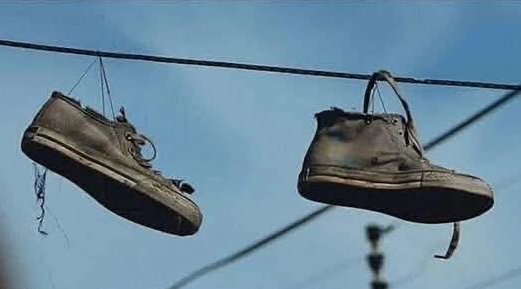Shoes hanging from power lines have become a curious sight in many places around the world—strange, symbolic, and often misunderstood. A pair of sneakers tied together and dangling above a street can carry different meanings depending on who sees them. Though less common than in the past, they still spark curiosity wherever they appear. The reality behind the practice, however, is more nuanced than the urban legends suggest.
One widely accepted explanation links the habit to the military. Some believe it began as a ritual for soldiers completing their service. After finishing a deployment or leaving the military, they would toss their boots over power lines to mark the end of a significant chapter in their lives. It symbolized leaving behind discipline and duty and stepping into civilian freedom—a small act of rebellion that also brought a sense of relief and achievement.
Over time, the meaning of shoes on power lines evolved and split into multiple interpretations. In some communities, they became associated with gangs and drugs. According to this idea, hanging sneakers might indicate a spot where drugs were sold or mark gang territory. This theory spread through rumors and media, particularly in urban areas. However, law enforcement and sociologists have repeatedly stated that there is no solid evidence to support this claim. It remains mostly an urban myth, popular because it seems plausible rather than true.
Another explanation links the act to bullying or humiliation. Movies and TV have reinforced this image—sneakers stolen from a bullied child and tossed over a wire as a form of public embarrassment. While such incidents occur, they don’t explain the widespread phenomenon. Mostly, this version reflects a pop culture trope rather than a social pattern.
For many young people, the reason is simpler. Throwing shoes onto power lines is often a spontaneous act of fun, rebellion, or boredom—a dare or prank. Teenagers might toss an old pair of sneakers just to see if they can reach the wire. For them, it is a fleeting form of self-expression, leaving a small mark on their neighborhood.
In some urban areas, hanging sneakers have taken on a more meaningful, almost artistic significance. They can symbolize identity or belonging—not for gangs, but for groups of friends, skaters, or street artists. Some see it as a form of grassroots urban art, a statement of presence in a world that often overlooks them. These sneakers can become local landmarks, representing memories, friendships, or turning points in life.
Sociologists note that the meaning of this practice changes depending on location and community. In one neighborhood, it may reflect nostalgia or local pride; in another, mischief or defiance. In rural areas, it is often just harmless fun, while in certain cities, it has been wrongly associated with crime. Its endurance lies in its many interpretations, shaped by context, rumor, and imagination.
Despite its symbolic or playful nature, throwing shoes onto power lines can be dangerous. Utility companies warn that shoes on high-voltage wires can interfere with electrical transmission, damage lines, or pose electrocution risks for workers. Dangling objects can even cause power outages or fires. What seems like a harmless prank can create serious safety hazards.
Removing shoes from power lines is also challenging. Technicians must use insulated equipment and sometimes temporarily shut down power. This costs time and money and puts workers at risk. Consequently, many cities have launched public awareness campaigns discouraging the practice and suggesting safer alternatives.
Recycling or donating old shoes is a far better option. Many organizations accept used shoes, refurbish them, and provide them to those in need—helping children in sports programs or supporting disaster relief. Worn-out sneakers can also be repurposed into playground surfaces, running tracks, or other products.
There is also a social lesson here about how communities create and interpret symbols. Shoes hanging from a wire tell a story, but the meaning depends entirely on who is looking. For some, it evokes youth and freedom; for others, suspicion or nostalgia. It shows that urban myths often reveal more about cultural imagination than reality. Ordinary objects, when placed out of context, can take on extraordinary significance.
Next time you notice sneakers swinging above your head, remember that the story behind them is human. It is about ritual, play, rebellion, and memory. It is about leaving traces of oneself in public spaces, whether through art, action, or impulse.
Yet safety should not be ignored. While sneakers on a wire may seem poetic, safer ways exist to celebrate freedom, mark a moment, or express oneself without endangering others or disrupting utilities.
Ultimately, hanging shoes combines history, myth, and mischief. From soldiers celebrating survival to kids testing gravity, from urban legends to real community expression, it captures the strange beauty of human behavior. Reasons may vary, but one thing is constant: a pair of shoes on a wire makes people look up, wonder, and talk about what it means.
